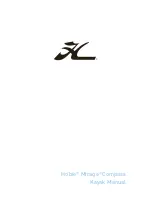
CS36T Owner’s Manual
Page 20
9
ENGINE CONTROLS and OPERATIONS
Engine Controls - the throttle and gear shift levers are mounted on the steering pedestal-- throttle to
starboard, shift to port. The stop pull is mounted alongside the engine instrument panel. For instructions
on engine starting, see Westerbeke Technical Manual, page 17 for W3- and page 8 for W33
Engine Instruments - consists of a standard Westerbeke panel comprising of tachometer, oil pressure
gauge, water temperature, ammeter and start. In addition, CS Yachts fit a rheostat switch for the
binnacle compass and manual pull stop for engine shutdown. Owners should refer to these instruments
when the engine is running. Operating figures are laid down in the Westerbeke Technical Manual.
9.1
Starting and Operating a Diesel
1.
Turn the main battery switch to either #1 or #2 position. (Do not- use the "BOTH" position
unless both sets of batteries are low. When the batteries are unevenly charged, selecting
"BOTH" will result in the more highly charged battery discharging into the lower one. When
engine is not running switch to ONE or TWO for DC services and keep one battery fully charged
for starting the engine.
2.
Check that engine water intake valve is open.
3.
Check that gear shift lever is in neutral and fuel throttle is half open.
4.
Push in key and hold for approximately 5-time clicks (15-20 seconds), then turn key fully
clockwise and start the engine.
5.
Check that the oil pressure gauge registers (50-70 PSI); check the exhaust port for water
discharge of engine coolant. If oil pressure gauge does not register or water is not being
discharged, shut down engine immediately.
6.
While the engine is warming up, monitor oil pressure and water temperature gauges. If normal
operation is not indicated, shut down engine and consult the manual for trouble shooting
suggestions
7.
Close throttle until engine idles at low (approximately 800-1000 RPM) before moving gear lever
into forward or reverse position.
8.
With folding propellers, excessive vibration may occur when the engine is put in forward gear.
This is usually caused by one blade of the propeller not opening. When this occurs, slow down
the engine, shift gear into reverse and accelerate engine. This usually opens the propeller. Slow
the engine down to idle and shift into forward gear.
9.
It is advisable to let the engine warm-up to full operating temperature (175-19OF) before
















































